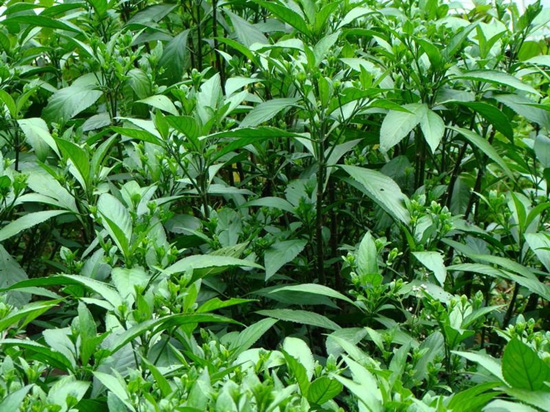In terms of medicinal herbs used in Chinese herbal treatments, they are classified into two major categories with similar characteristics – Isatis tinctoria L. and Isatis indigotica Fort. in the north China (Bei Ban lan) and Baphicacanthus cusia (Nees) Brem. in the south China (Nan Ban Lan). Actually the former is in the family of Brassicaceae while the latter of Acanthaceae. Else, other common names for it include Isatidis Radix (Radix isatidis), indigowoad root, banlangen, isatis indigotica root, Da Qing Ye, woad root, and indigo root, etc.
It has an elongated cylindrical body, about 10 to 30cm long, and 3 to 8mm in diameter. The surface is light greyish-yellow, rough, with lognitudinal wrinkles, horizontal blackspots, and rootlet scars, hollowness on top, dark green petiole residue surrounded, and dense verruca and greyish brown petiole scars arrayed in ring shape in thicker rhizome. The texture is solid and crisp. The transverse section is with yellowish white to light brown cortex and yellow xylem. It has little odor and slightly sweet taste. Medicinally the thicker, solider, and better mealiness is preferred.
WHAT IS IT USED FOR?
Being one of traditional Chinese herbs, it is believed as bitter and cold in nature and covers meridians of liver and Stomach. Main functions are to clear heat-toxicity, cool blood, and relieve sore throat. Main usage and indications are macula due to pestilential toxicity invasion, high fever, Headache, infection with swollen head, dark reddish purple tongue, scarlet fever, Erysipelas, mumps, Chronic Pharyngitis, sore boils and bunacles, chicken pox, measles, Virus Hepatitis, cold and flu, epidemic cerebrospinal meningitis, epidemic encephalitis B, Pneumonia, unconsciousness, Hematemesis, bleeding from five sense organs or subcutaneous tissue, swollen throat, pinkeye causing by inflammation, shingles, and osteomyelitis, etc. Usual dosage is 15 to 30 grams.

Isatis Root
The Outline of Antivirus Combination Therapy In China, the report made by Zhong Nan Shan (the academician and the president of The Chinese medical association), pointed out that this herb was the classic antivirus representative among so many Chinese herbs, which was drawn based on its extraordinary performance during SARS. Actually then it impressed the world so greatly that it receives more and more attentions ever since.
RELATED CHINESE HERBAL FORMULAS
(1). Recorded in Jiangsu Yan Fang Cao Yao Xuan Bian (A Source Book In Empirical Herbal Prescriptions In Jiangsu), it combines with Qiang Huo (Notopterygium Root) in decoction to cure influenza;
(2). Pu Ji Xiao Du Yin, from Dong Yuan Shi Xiao Fang ( Dongyuan’s Effective Prescription) by Li Gao, is mainly for swollen head plague. Other herbal ingredients are Huang Qin (Scutellaria), Huang Lian (Coptis Rhizome), Chen Pi (Tangerine Peel), Gan Cao (Licorice Root), Xuan Shen (Ningpo Figwort Root), Lian Qiao (Forsythia Fruit), Ma Bo (Fruiting Body of Puffball, Lasiosphaera), Niu Bang Zi (Great Burdock Fruit, Arctium), Bo He (Field Mint, Mentha), Jiang Can (Silkworm), Sheng Ma (Black Cohosh Rhizome, Bugbane Rhizome), Chai Hu (Bupleurum), and Jie Geng (Balloon Flower Rhizome);
(3). According to Quan Zhan Xuan Bian – Ai Guo Wei Sheng, the following recipe was used to prevent mumps. Other herbs in this recipe include shan Ci Gu (Cremastra), Lian Qiao, Gan Cao, and Qing Dai (Indigo Naturalis);
(4). According to Liao Ning Chang Yong Zhong Cao Yao Shou Ce (Manual of Commonly Used Chinese Herbs in Liaoning Province), it treated liver cirrhosis along with Yin Chen Hao (Yin Chen Hao Shoots and Leaves), Yu Jin (Tumeric Tuber), and Yi Yi Ren (Seeds of Job’s Tears);

![Diseases, Symptoms, tcm, [tcmwindow.com]](/uploadFile/adImg/2015/11/11/f5cbfcc0-4df5-4646-9b9a-f316651a0199.jpg)





